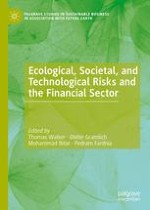2020 | OriginalPaper | Chapter
5. Designing Insurance Against Extreme Weather Risk: The Case of HuRLOs
Authors : Martin Boyer, Michèle Breton, Pascal François
Published in: Ecological, Societal, and Technological Risks and the Financial Sector
Publisher: Springer International Publishing
Activate our intelligent search to find suitable subject content or patents.
Select sections of text to find matching patents with Artificial Intelligence. powered by
Select sections of text to find additional relevant content using AI-assisted search. powered by
